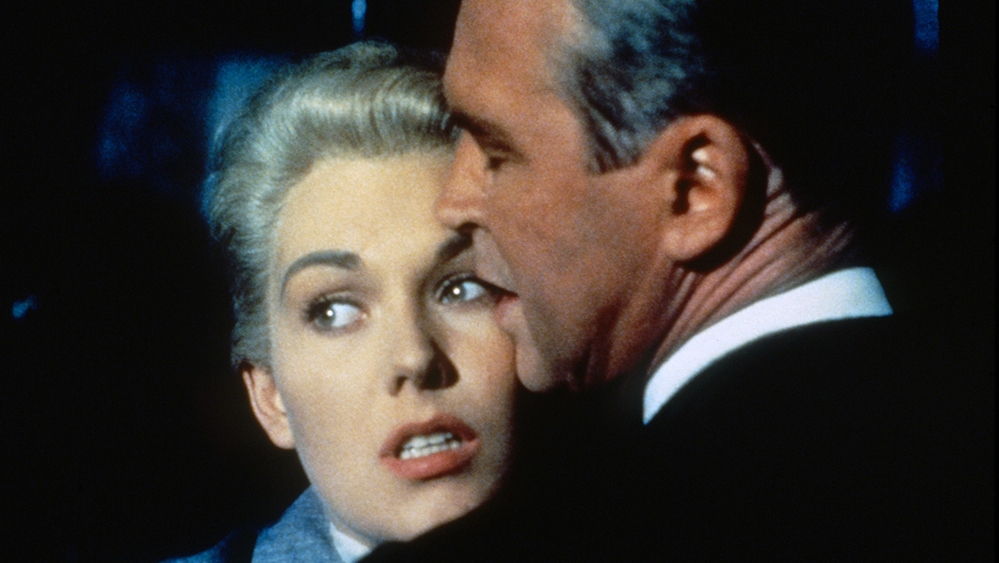
The headline of this column is doubtlessly unfair. I’m judging a movie before I’ve seen it, before it has even been made. Given the vast volume of junky indifferent product that now slides through the megaplex, and the streaming ocean, on a weekly basis, why not settle in for an ambitious remake of “Vertigo,” Alfred Hitchcock’s romantically kinky and voluptuous dream thriller of 1958? At least it’s not “Texas Chainsaw XVIII” or another “Minions” movie. At least it will be interesting (right?).
Robert Downey Jr., who is in talks to produce and possibly star in a remake of “Vertigo” at Paramount (home of the original film), is a great actor. But once he became a box-office superstar, 15 years ago, with “Iron Man,” he got sucked into the escapist vortex of Marvel and “Sherlock Holmes” and duds like “Dolittle.” Downey, who is about to turn 58, needs to rediscover himself as an actor. Couldn’t he accomplish that by taking on the role of the obsessive detective that James Stewart, who was 49 when he starred in “Vertigo” (but looked 10 years older than Downey), fashioned into one of his own greatest performances?
Yes, yes and yes. And also no, no and no. A remake of “Vertigo” could theoretically be a good movie, but I wouldn’t bet on it. I’m not alone in thinking that it sounds like a very bad idea. Not because the film will necessarily be a travesty, but because of the idea behind the idea. What does it mean when the entire Golden Age of Hollywood gets reduced to IP? If they can do it to “Vertigo,” they can do it to anything. And that’s a travesty.
You could argue, of course, that that particular ship of corruption sailed long ago. The 1980s was the decade that formed the template of the all-popcorn-all-the-time movie universe we now occupy, and that meant several things at once. It meant action franchises (“Conan the Barbarian,” “Rambo”), comedy franchises (“Porky’s,” “Police Academy”) and horror franchises (“Halloween,” “A Nightmare on Elm Street”). It meant the endless churn of sequels to movies both good (“Raiders of the Lost Ark,” “Airplane!”) and awful (“The Amityville Horror,” “The Cannonball Run”). Beyond that, it meant remakes, the beginning of the process of strip-mining the movie past to create the endlessly derivative and familiar movie future.
The ’80s gave us remakes of classic horror (“The Thing,” “Cat People,” “The Fly”), of classic thrillers (“Out of the Past,” which became “Against All Odds”; “Double Indemnity,” which became “Body Heat”), of art films (“The Man Who Loved Women”), of studio-system comedies (“Unfaithfully Yours”). It gave us a remake of Jean-Luc Godard’s “Breathless” starring Richard Gere! Talk about blasphemy. But true confession: I liked the “Breathless” remake, which hasn’t exactly replaced the original. It was a lark crushed by the weight of film history, and film history moved on.
In the decades since, there have been remakes of all kinds of hallowed cinema landmarks, many directed by high-end filmmakers. Consider Steven Spielberg’s “West Side Story,” Martin Scorsese’s “Cape Fear,” Jonathan Demme’s “The Manchurian Candidate,” Bradley Cooper’s “A Star Is Born,” the Coen brothers’ “True Grit,” Irwin Winkler’s “Night and the City,” Spike Lee’s “Oldboy,” and, of course, Gus Van Sant’s infamous shot-for-shot remake of “Psycho,” a folly that was hell to sit through but fascinating to think about. Maybe that kind of movie had to be tried… once. And once again, film history moved on.
But the notion of remaking “Vertigo” feels new and different, even though the film was already remade once, back in 1976. It was a big studio picture, titled “Obsession,” that represented a stepping stone for director Brian De Palma. For the first time, De Palma did his own variation on Hitchcock’s gliding and circling camera movements, creating a voluptuous heightened distillation of the Hitchcock essence (a technique he’d employ with playful virtuosity later that year in “Carrie”). You might say that De Palma has spent half his career remaking “Vertigo” — not literally, but in spirit, trying to recapture that sensuous tracking-shot voyeurism (“Body Double”), that fusion of flotation and loss (just think of the ending of “Blow Out”). The paradox of “Obsession” is that it’s actually a rather tinny movie, fondly remembered by some for Cliff Robertson’s performance and little else.
At that point, “Vertigo” was just 18 years old and thought of as a fascinating Hitchcock curio. It didn’t enjoy the full ecstatic reputation it does today as one of the Hitchcock’s two or three crowning achievements. The 2012 Sight & Sound poll canonized “Vertigo” as the greatest movie ever made. Just because the Sight & Sound poll said so, of course, doesn’t make it true (last year, the poll cast “Vertigo” aside for the avant feminist rigor of “Jeanne Dielman”), but it officialized a certain echelon of esteem on which many of us place “Vertigo.” It’s not simply that the movie is heady, hypnotic, entrancing. It is singular, a poem of swooning suspense in the form of a streets-of-San-Francisco femme-fatale meta ghost thriller. How do you remake that? You don’t. All you can do is reduce it.
But if you’re still calling it “Vertigo,” you’re making a statement: that anything is now fair game. In the 21st century, we fetishize a lot of the 20th century: vinyl, Atomic Age design, Elvis Presley, early 1970s muscle cars, charismatic authoritarianism. “Vertigo,” if you strip away its tricky layered mystery plot, is a movie about fetishism (Stewart’s Scottie Ferguson can’t fall fully back in love with the woman he loved from the past until she has the right hair and dress and look — the right visual identity), and “Vertigo” itself has become a kind of fetish object for movie maniacs. The film’s shots are like paintings, the locations (the Golden Gate Bridge, the Mission San Juan Bautista) more real on film than they are in reality. How do you remake that?
You don’t, but it feels as if the industry has come to a place where it says, “Heck, why not leech off a masterpiece?” Imagine that a couple of years from now, Sam Mendes’ “Vertigo” (no, he has not been mentioned as a possible director — I just wanted to spook you) is a surprise hit. Imagine that the critics are kind and that Robert Downey Jr. enjoys a reunion with his cred. What comes next? We all know that the film industry never met a trend it couldn’t milk. If “Vertigo” can be IP, then why not “Casablanca”? “Singin’ in the Rain”? “The Searchers”? “The Wizard of Oz”? “Rebel Without a Cause”? Are you ready for “Citizen Kane 2025”? It’s the story of a legendary social-media mogul with too much power and a mysterious dying word (“Earbud!”) that symbolizes his lost mother’s love.
You can see where this is going, yet you might think we’re already there. When it comes to remakes, Hollywood cast aside its shame a long time ago. Yet maybe it held onto a little shame, and a bit of pride to go along with it. There are lines, up until now, no one would cross. “Vertigo,” with the stature it has attained, might be one of those lines. You don’t remake a film where the whole hook of the remake is that the original is so monumental, so transcendent, with such a mythic place in the culture that there’s no way it could ever be matched. So why try? To demonstrate that even if a work of art can’t be matched, it’s still something the corporation can conquer.













